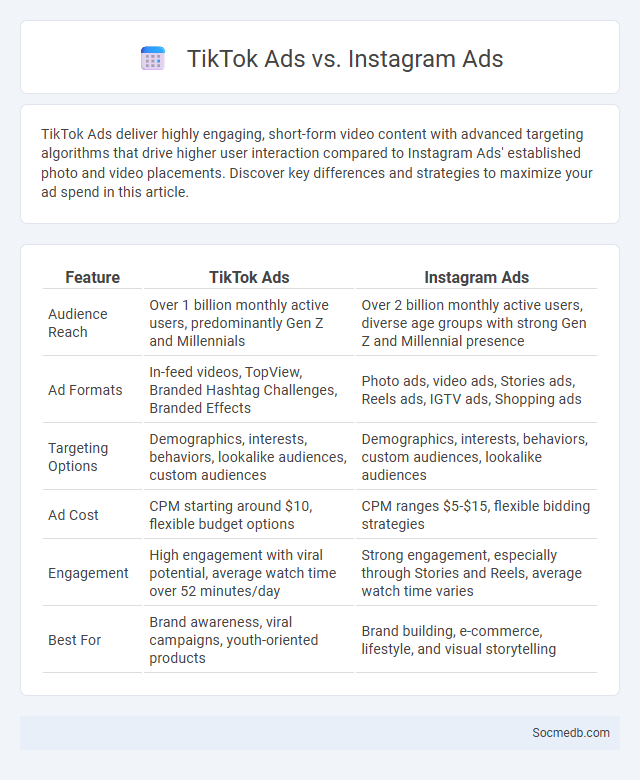
Photo illustration: TikTok Ads vs Instagram Ads
TikTok Ads deliver highly engaging, short-form video content with advanced targeting algorithms that drive higher user interaction compared to Instagram Ads' established photo and video placements. Discover key differences and strategies to maximize your ad spend in this article.
Table of Comparison
| Feature | TikTok Ads | Instagram Ads |
|---|---|---|
| Audience Reach | Over 1 billion monthly active users, predominantly Gen Z and Millennials | Over 2 billion monthly active users, diverse age groups with strong Gen Z and Millennial presence |
| Ad Formats | In-feed videos, TopView, Branded Hashtag Challenges, Branded Effects | Photo ads, video ads, Stories ads, Reels ads, IGTV ads, Shopping ads |
| Targeting Options | Demographics, interests, behaviors, lookalike audiences, custom audiences | Demographics, interests, behaviors, custom audiences, lookalike audiences |
| Ad Cost | CPM starting around $10, flexible budget options | CPM ranges $5-$15, flexible bidding strategies |
| Engagement | High engagement with viral potential, average watch time over 52 minutes/day | Strong engagement, especially through Stories and Reels, average watch time varies |
| Best For | Brand awareness, viral campaigns, youth-oriented products | Brand building, e-commerce, lifestyle, and visual storytelling |
TikTok Ads vs Instagram Ads vs Vertical Video: An Overview
TikTok Ads leverage algorithmic content discovery to boost engagement through authentic, short-form vertical video that resonates with younger audiences, driving higher conversion rates compared to traditional platforms. Instagram Ads offer robust targeting and diverse formats like Stories, Reels, and carousel ads, making them ideal for brands aiming to reach a broad demographic with visually rich content. Your marketing strategy benefits from understanding that vertical video content thrives on both platforms, but TikTok's native format and advanced AI-driven personalization often outperform Instagram in user interaction and viral potential.
Audience Demographics and Reach Comparison
Understanding social media audience demographics is crucial for tailoring content that resonates with your target market, with platforms like Instagram attracting younger users aged 18-34 while Facebook's user base skews older. Reach comparison reveals that TikTok offers rapid viral growth potential due to its algorithm favoring engagement, whereas LinkedIn excels in professional networking and B2B marketing reach. Your strategic choice of platforms should align with where your ideal audience spends the most time and how they engage with different content formats.
Ad Formats: TikTok, Instagram, and Vertical Video Explained
TikTok and Instagram dominate social media with diverse ad formats tailored for high engagement, including in-feed ads, branded effects, and Stories placements that leverage vertical video to capture attention quickly. Vertical video, optimized for mobile viewing, enhances user interaction by filling the entire screen and providing immersive, full-screen experiences that align with natural phone use. Understanding these formats helps you create compelling campaigns that maximize reach and boost conversions on popular platforms.
Engagement Rates: Which Platform Performs Best?
Instagram consistently achieves the highest engagement rates among social media platforms, with averages reaching up to 4.7% per post compared to Facebook's 0.09% and Twitter's 0.045%. TikTok also shows impressive performance, especially among younger audiences, boasting engagement rates around 5-6%. To maximize your content's impact, focus on platforms like Instagram and TikTok that prioritize visual and interactive formats, driving stronger user interaction and community growth.
Creative Strategies for Vertical Video Success
Creative strategies for vertical video success center on engaging storytelling that maximizes screen real estate on mobile devices. Utilizing bold visuals, concise messaging, and interactive features like polls or swipe-ups boosts viewer retention and shares. Brands leveraging data-driven insights to tailor content for platform-specific trends see significantly higher engagement and conversion rates.
Budgeting and Cost Efficiency: Where’s Your ROI?
Maximizing ROI on social media requires strategic budgeting that targets high-impact platforms and content types tailored to your audience. Analyzing engagement metrics and conversion rates helps you allocate resources efficiently, ensuring every dollar spent drives measurable business growth. Your focus should be on cost-effective campaigns with clear performance indicators to optimize long-term investment returns.
Targeting and Personalization Features
Social media platforms utilize advanced targeting and personalization features to deliver tailored content based on user demographics, interests, and online behavior. These algorithms analyze data points such as location, age, browsing history, and interaction patterns to optimize ad relevance and user engagement. Enhanced personalization increases conversion rates by ensuring that marketing messages resonate with specific audience segments in real-time.
Analytics and Performance Tracking
Social media analytics enable businesses to measure key performance indicators such as engagement rate, reach, and conversion metrics, providing critical insights into audience behavior. Advanced performance tracking tools integrate real-time data to optimize content strategy, boosting your brand's visibility and ROI. Leveraging these analytics helps you make informed decisions to enhance campaign effectiveness and maximize social media impact.
Case Studies: Brands Crushing It with Short-Form Video
Brands like Nike and Dunkin' have harnessed the power of short-form video on platforms such as TikTok and Instagram Reels to boost engagement and sales. Nike's campaign featuring dynamic workout clips and motivational messages drove a 50% increase in user interactions within the first quarter. Dunkin's use of playful, relatable content led to a 30% growth in brand mentions and a significant uptick in mobile app downloads.
Choosing the Best Platform for Your Marketing Goals
Selecting the best social media platform depends on your target audience, industry, and marketing goals. Instagram excels for visual content and younger demographics, while LinkedIn is ideal for B2B marketing and professional networking. Analyzing platform user statistics and engagement rates ensures alignment with your brand's objectives and maximizes campaign effectiveness.
 socmedb.com
socmedb.com